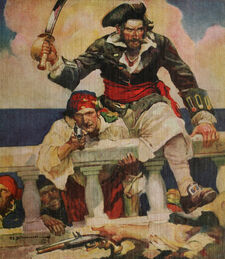
Illustration from the front cover of the 1922 book Blackbeard, Buccaneer.
Pirates have become associated with Halloween largely due to the popularity of the pirate costume.
Among other meanings, "pirate" refers to a type of criminal who operates from a ship, usually at sea, and who attacks and robs other ships, taking the cargo and/or the passengers' possessions. Pirates sometimes go ashore to attack and loot nearby cities, towns or villages.
History
Pirates have probably existed for as long as people have been traveling on water. The earliest known document which refers to pirates dates from the 14th century BCE. In 75 BCE, Julius Caesar was held captive by pirates who were originally going to demand a ransom of twenty gold coins for his safe return. Caesar protested that he was worth at least fifty gold coins and the pirates raised the ransom accordingly.
The Scandinavian Vikings acted as pirates between the 8th and 12th centuries. They attacked towns and cities on the coast of Western Europe, reaching as far south as Spain, Italy and even North Africa. They used rivers to sail into Eastern Europe, eventually reaching the Black Sea and Persia.
In 1241, the pirate William Maurice became the first person in England to be executed by being hanged, drawn and quartred - that is to say, he was hanged by the neck until he was nearly dead, his entrails were removed from his body while he was still alive and he was finally killed by having his body cut into four pieces.

1888 depiction of Captain Kidd.
Ships carrying gold from the New World to Spain began to attract pirates to the Caribbean Sea in 1523. The "Golden Age of Piracy" in the Caribbean lasted until the 1730s. Most of the pirates who operated there were British, French or Dutch and usually attacked Spanish and Portuguese ships. Some of the best known of those pirates include Captain Henry Morgan (1635-1688), Jack Rackham, also known as Calico Jack (1682-1720), Bartholomew Roberts, also known as Black Bart (1682-1722), William Kidd (1645-1701) and Edward Teach, better known as Blackbeard (1680-1718). Many pirates who operated in the Caribbean also attacked coastal towns in what is now the United States, Blackbeard blockaded the port of Charleston, South Carolina in May 1718. Pirate attacks along the coast of North America remained frequent until the 1870s.
Piracy continues to be a serious problem today, particularly in the territorial waters of Indonesia, Malaysia and Singapore and off the coast of East Africa.
In fiction

Cartoon image of a stereotypical pirate.
The popular image of pirates today largely derives from the 1881 children's adventure novel Treasure Island by Robert Louis Stevenson[1] Such familiar elements as one-legged pirates with parrots on their shoulders, buried treasure and treasure maps on which X marks the spot were introduced in Treasure Island. Other major influences include Gilbert and Sullivan's 1879 operetta The Pirates of Penzance, in which the Pirate King leads a largely inept band of pirates who live by a strict code of honor, and J.M. Barrie's 1904 play Peter Pan and its 1911 novelization Peter and Wendy, in which the hook-handed Captain Hook makes his captives walk the plank. What is now generally considered to be the "pirate voice" is largely based on the accent used by Robert Newton as Long John Silver in the 1950 Disney movie version of Treasure Island. Newton was a native of England's West Country, which was also the home of the historical pirates Blackbeard and Calico Jack.
Pirates continue to appear frequently in popular culture. They are sometimes depicted as pure evil villains who have to be defeated by the hero but are more usuually presented as dashing rebels.
Footnotes
- ↑ Stevenson also wrote the famous horror story Strange Case of Dr. Jekyll and Mr. Hyde.
External links
- Wikipedia's article on piracy.
- Pirate on TV Tropes.
- Pirate Wiki and Anything Pirates Wiki.
